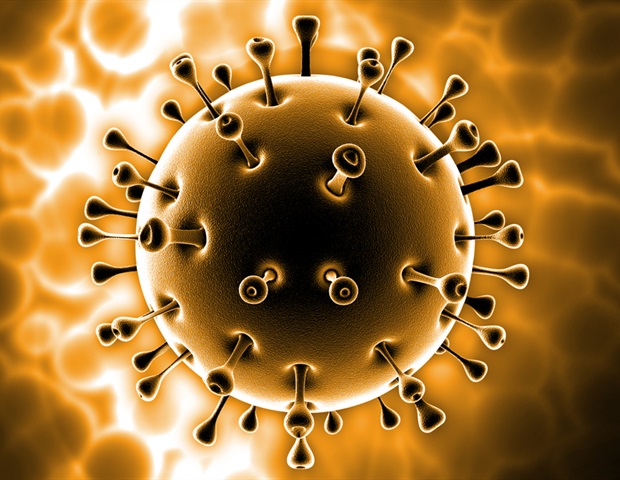A staff led by Jose Onuchic at Rice College and Paul Whitford at Northeastern College, each researchers on the Nationwide Science Basis Physics Frontiers Heart on the Heart for Theoretical Organic Physics (CTBP) at Rice, has made a discovery within the struggle in opposition to extreme acute respiratory syndrome coronavirus-2 (SARS-CoV-2), the virus chargeable for COVID-19.
The staff, in partnership with an experimental effort led by Yale College researchers Walter Mothes and Wenwei Li, has uncovered new insights into how the virus infects human cells and the way it may be neutralized. Their findings had been revealed within the journal Science on Aug. 15.
SARS-CoV-2 makes use of its spike protein to connect to the angiotensin-converting enzyme 2 on human cells, initiating a course of that permits it to enter the cell. The spike protein has two primary elements: the S1 area, which varies tremendously amongst completely different strains of the virus, and the S2 area, which is extremely conserved throughout completely different coronaviruses. This similarity makes the S2 area a promising goal for vaccines and therapies that might work in opposition to many virus strains.
By combining simulations and theoretical predictions with structural data from their experimental collaborators, together with preliminary and ultimate configurations in addition to intermediate states throughout the viral invasion, the researchers obtained an in depth image of the an infection course of at an atomic degree.
“Understanding these intermediate states of the spike protein creates new alternatives for therapy and prevention,” stated Onuchic, the Harry C. and Olga Ok. Wiess Chair of Physics, professor of physics and astronomy, chemistry and biosciences and co-director of CTBP. “Our work demonstrates the significance of mixing theoretical and experimental approaches to sort out complicated issues akin to viral infections.”
Utilizing a sophisticated imaging method referred to as cryo-electron tomography, the experimental researchers at Yale captured detailed snapshots of the spike protein because it modifications throughout the fusion course of.
They found antibodies concentrating on a particular a part of the S2 area, referred to as the stem-helix, which may bind to the spike protein and cease it from refolding right into a form vital for fusion. This prevents the virus from getting into human cells.
Our research supplies an in depth understanding of how the spike protein modifications form throughout an infection and the way antibodies can block this course of. This molecular perception opens up new potentialities for designing vaccines and therapies concentrating on a variety of coronavirus strains.”
Jose Onuchic at Rice College
The researchers used a mix of theoretical modeling and experimental information to realize their findings. By combining simulations of the spike protein with experimental photographs, they captured intermediate states of the protein that had been beforehand unseen. This built-in method allowed them to grasp the an infection course of at an atomic degree.
“The synergy between theoretical and experimental strategies was essential for our success,” stated Whitford, a professor within the Division of Physics at Northeastern. “Our findings spotlight new therapeutic targets and techniques for vaccine improvement that may very well be efficient in opposition to most variants of the virus.”
The staff’s discovery is important within the ongoing efforts to fight COVID-19 and put together for future outbreaks of associated viruses. By concentrating on the conserved S2 area, scientists can develop vaccines and therapies that stay efficient even because the virus mutates.
“This analysis is a step ahead within the struggle in opposition to COVID-19 and different coronaviruses that will emerge sooner or later,” stated Saul Gonzalez, director of the U.S. Nationwide Science Basis’s Physics Division. “Understanding the elemental bodily workings inside intricate organic mechanisms is important for creating more practical and common therapies that may defend our well being and save lives.”
This work was supported by the Nationwide Science Basis, Nationwide Institutes of Well being, Canadian Institutes of Well being Analysis, Canada Analysis Chairs and Welch Basis.
Different researchers embrace Michael Grunst and Zhuan Qin on the Division of Microbial Pathogenesis and Shenping Wu on the Division of Pharmacology at Yale; Esteban Dodero-Rojas at CTPB; Shilei Ding, Jérémie Prévost and Andrés Finzi on the Centre de Recherche du CHUM; Yaozong Chen and Marzena Pazgier within the Infectious Illness Division within the F. Edward Hebert Faculty of Drugs at Uniformed Companies College of the Well being Sciences; and Yanping Hu and Xuping Xie within the Division of Biochemistry and Molecular Biology on the College of Texas Medical Department at Galveston.
Supply:
Journal reference:
Grunst, M. W., et al. (2024). Construction and inhibition of SARS-CoV-2 spike refolding in membranes. Science. doi.org/10.1126/science.adn5658.

0 Comments